30.11.2005
S.KLIMOV. WORLD TEAM CHAMPIONSHIP REVIEW
The reader that followed the world team championship on our and other chess cites must be well acknowledged with captivating intrigue of the competition – race of Russian and Chinese teams, sudden defeat of the Chineses by the Armenians, and finally a miraculous victory of the Russian team over the leader in the last round with almost clear score 3,5:0,5. There is no use to retell it again or to pour out our delights with class and play of our team and tell about the place of Russia in contemporary chess world. Those willing to examine closely the way this tournament was played can read Alexei Bezgodov's articles on ChessPro.ru (only in Russian, though); and as usual, I will tell about already annotated games either when I have some essential additions to Alexei's annotations or if I cannot but cite them in the review. This time there were a few brilliances on the tournaments. Maybe it was connected with bad form of the main provider of masterpieces, Emil Sutovsky. Nevertheless, one game shall get the first place in the top weekly charts or even take its place among the best games of the year because of the extremely brave positional play in it. I would like to ask the reader not to put fritzes, juniors, crafties and other hydras on: they will inevitably show you that Black had a lost position starting from the sacrifice almost until the exchange of queens. So I encourage you to put the pieces on board and see the game in the normal and not two-dimensional view. L.Bruzon-V.Ivanchuk B92 This was a very interesting game with purely positional sacrifice of an exchange and a pawn for dark squares, and an extremely unusual raid of Black's king to the opponent's camp (in the middlegame!). To understand the actions that took place in it, one has to consider the situation on other boards during the match. Eljanov lost the game to Nogueiras in 30 moves, Volokitin and Karjakin could not get anything as White, so the only chance to save the match was Ivanchuk's victory. That is why Black obviously avoids all forced continuations from some moment and holds the tension. 1.e4 c5 2.¤f3 d6 3.d4 cxd4 4.¤xd4 ¤f6 5.¤c3 a6 6.Ґe2 e5 7.¤b3 Ґe7 8.g4. It is the idea that Garry Kasparov suggested to name after Nigel Short in the middle 90s when applied to Najdorf variation (the English grandmaster tested this variation in almost all the branches of the system, and here also). 8...h6 9.Ґe3 (the alternative is 9.f4) 9...Ґe6 10.¦g1 ¤c6. The main theoretical continuation is 10...¤bd7 11.h4 ¤h7 12.g5 hxg5 13.hxg5 Ґxg5 14.Ґxg5 ¤xg5 15.Јxd6. 11.¤d5. Here 11.h4 is ineffective because of 11...d5 or the same 11...¤h7. 11...¦c8 12.Ґf3 Ґxd5 13.exd5 ¤a5. The results of the opening are rather favorable for Black – the g2-g4 advance does not suit in this position. 14.¤d2 ¤c4. 14...e4 15.¤xe4 ¤xe4 16.Ґxe4 ¤c4„, suggested by Alexei Bezgodov, is also interesting. 15.¤xc4 ¦xc4 16.Ґe2 And here we saw a Petrosian-like sacrifice: 16...¦e4!? 17.Јd2 ¤d7 18.Ґd3 ¦xe3+ 19.fxe3 Ґh4+ 20.ўe2 Another addition to White's ration – 20...e4 21.Ґxe4 0–0 22.¦af1 ¦e8 Further actions of Lazaro Bruzon are strong and logical – he leads the king to the safe place without losses. One can hardly propose anything better. 23.Ґf5 ¤e5 24.Јb4 b5 25.Ґd3 Ґg5 26.¦g3 Јb6 27.Јe4 g6 28.ўd1 b4 29.ўc1 a5 30.ўb1 a4 31.Јd4 Јa5 32.e4 32...b3 33.Ґe2. A sensible move. White wants to use the g3-rook – to transfer it to the queenside and attack the a4-pawn. However, I like 33.a3!? no less, planning to exchange on b3 and attack Black's last pawn left on the flank. Exemplary variations are 33...¦b8 (33...Јd2 34.Јxa4 ¦b8) 34.cxb3 axb3 (34...¦xb3 35.Ґc2) 35.Ґe2, then h3, ¦c3, Ґd1. Here White's king is better protected than in the game. 33...bxa2+ 34.ўxa2 ¦b8 35.¦a3 ¦b4 36.Јc3 Јb6 37.Ґd3 Ґe3. Here one could capture a pawn – 37...¤xg4, and after that winning the knight leads to a draw: 38.Јc8+ (38.Јc6 ¦xb2+ 39.ўa1 Јb8 40.¦xa4 Ґf6 41.c3 ¦b6) 38...ўg7 39.Јxg4 ¦xb2+ 40.ўa1 Јb4 41.¦xa4 ¦b1+ 42.¦xb1 Јxa4+ 43.ўb2 Јb4+=. However, we have already talked about it – Ivanchuk had to win. 38.¦b1 Ґc5. 38...¤c4 39.Ґxc4 (39.Јxc4 ¦xc4 40.Ґxc4 Јb4 41.Ґd3 Ґc5 is analogous) 39...Ґd4 40.Јxb4 Јxb4 41.Ґd3 Ґc5. Probably Black is not losing here – it is not clear how White should advance the queenside pawns (it will weaken the king), but he is not winning, too. Ivanchuk changes nothing and continues playing on the dark squares. 39.b3 axb3+ 40.¦bxb3 ўg7 41.¦xb4 Ґxb4 42.Јb2 Јc5 43.¦a4 Ґe1 44.h3 Ґf2 45.¦a8. 45...ўf6!? The last reserve – otherwise everything in White's camp is protected. 46.Јa3 Јc7 47.Јb4. It seems that the king's raid is prevented, because ўg5 will now be followed by check from d2, and he loses the h6-pawn. 47...Ґb6 48.ўb3. If White wanted to exchange the queens as it becomes clear from the following moves, it could be done here and under better circumstances than on the 51st move: 48.¦a6 Ґc5 49.Јa5 Јxa5+ (49...Јb7? 50.Јd8+ ўg7 51.¦a8; 49...Јd7? 50.Јxc5ќ; 49...Јc8 50.¦a8 Јd7 51.Ґb5 Јe7 52.¦e8) 50.¦xa5 – Black's king is still on f6, and not on h4! 50...ўg5 51.ўb3 ўh4 52.Ґf1. 48...ўg5. Nevertheless! 49.Јd2+ ўh4 50.ўa2 Ґc5. 51.Јa5. This move can only be explained by confusion or wish to make a draw and fix the team result. After 51.Ґf1!? or banal capture on h6 one cannot mate black king properly (because there is only the queen to mate with, as the rook cannot return), but still these were moves to play. Moreover, it is not quite clear how the king on g3 increases Black's threats that much. 51...Јxa5+ 52.¦xa5 ўxh3 53.Ґe2 ўg3 (53...¤xg4? 54.¦xc5ќ) 54.¦a8 ўf4 54...¤xg4 55.Ґxg4 ўxg4 56.¦f8 f5 57.exf5 gxf5 58.¦g8+ with a draw by attacking f5, h6 and the king. 55.¦h8 ўxe4 56.¦xh6 ўxd5 Objectively White does not have to lose, but he will have to defend for a while. 57.ўb3 ўe4 58.¦h7 ўf4 59.ўc3 d5 60.¦h8 ўe3 61.¦e8?? Vassily Ivanchuk's pressure brings results. 61.¦h2 d4+ (61...f5 62.gxf5 gxf5 63.Ґf1 … ¦e2+) 62.ўb3 Ґd6 63.Ґd1 (63.¦g2 f5 64.gxf5 gxf5 65.Ґd1=), and White has to make a draw, because 63...¤xg4 will be followed by 64.¦h3+ ўf4 65.¦f3+ ўe4 66.¦xf7. 61...Ґd4+ 62.ўb4 ўxe2 63.c3 ўd3 64.cxd4 ўxd4° 65.g5 ¤f3 66.¦e7 ¤xg5 67.ўb5 ¤e4 68.ўc6 f5 69.¦d7 ¤f6 70.¦g7 ¤g4 71.ўd6 ¤e5 72.ўe6 f4 73.¦g8 ўe4 74.¦d8 f3 75.¦xd5 f2 76.¦d1 g5 77.¦f1 0–1 This game reminds of immortal works of Tigran Petrosian senior and Ulf Andersson. Let me cite one of them: G.Kasparov-U.Andersson 13...¦xe3 14.fxe3 g6 15.0–0 Јe7 16.Јd4 Ґg7 17.Јf4 ¤e8 18.¦ac1 Ґe5 19.Јf2 ¤df6 20.Ґd3 h5 21.¤ge2 ¤h7 22.¤f4 ¤f8 23.¤b5 a6 24.¤d4 Ґd7 25.¦c2 Ґg7 26.Јg3 ¦b8 27.¦e2 ¤f6 28.¤f3 Ґe8 29.e4 ¤6d7 30.¦c2 ¤e5 31.¤xe5 Ґxe5 32.Јf2 ¤d7 33.b4 Јd8 34.Ґe2 Ґg7 35.¤d3 ¤e5 36.¤xe5 Ґxe5 37.¦fc1 ўg7 38.¦c7 Јg5 39.¦1c2 h4 40.Ґg4 ўh6 41.ўh1 b6 42.¦a7 Ґg3 43.Јd2 Ґf4 44.Јd4 Ґe5 45.Јg1 a5 46.Јc1 Ґf4 47.Јa1 Ґe5 48.Јg1 axb4 49.axb4 Ґf4 50.Јa1 Ґe5 51.Јa3 ўg7 52.¦f2 Ґf6 53.Јd3 Јe5 54.Ґe6 ўg8 55.Јf3 ўg7 56.Јf4 Јd4 57.¦f1 b5 58.Ґg4 ¦d8 59.¦c7 Јb2 60.¦c2 Јd4 61.¦d2 Јe5 62.Јxe5 Ґxe5 63.¦c2 Ґd7 64.Ґe2 f5 65.¦c7 ўh6 66.Ґd3 fxe4 67.Ґxe4 ўg5 68.Ґd3 Ґd4 69.¦b7 Ґc3 70.Ґxb5 Ґf5 71.Ґe2 ¦a8 72.b5 ¦a2 73.Ґf3 ¦b2 74.¦b8 Ґd4 75.¦d1 Ґc5 76.ўh2 Ґe3 77.¦e1 Ґf2 78.¦f1 Ґc5 79.¦e8 Ґd4 80.¦d1 Ґf2 81.Ґe2 Ґd7 82.¦e4 Ґf5 83.¦e8 Ґd7 Ѕ–Ѕ Actually a majority of dubious sacrifices in the championship did not work out, as an example of Sutovsky shows: he lost three games (to Morozevich, Zhang Pengxiang, Pantsulaia) after unsound material offers. Emil hardly even managed to initiate the play. E.Sutovsky-L.Pantsulaia If in this position White had had the pawn not on g3, but on g2 (and, accordingly, on h2, and not on h4), the chances for the attack would have been higher – for example, one could have made a rook lift on the 3rd rank. It seems that one has to make a couple of solid moves like Ґe3 and ўg2 and offer a draw... but Sutovsky began to search for the attack and found it to his own misfortune. 19.¤h5 ўh7 20.¤xg7? ўxg7 21.Јg4+ ўh7 22.Јh5 Јe8. It is a good but rather simple move. 23.Јxh6+ (23.Ґxh6 f5°) 23...ўg8 24.g4 It seems that 24...f6 is prevented in view of 25.g5; but not everything is clear there: 25...¦f7 26.gxf6 ¤xf6 27.exf6 ¦xf6 28.Јe3 cxd4 29.cxd4 Јh5, and White is about to kiss the dust. But the refutation turned out to be even simpler... 24...cxd4 25.cxd4 ¦c4 26.Ґe3 ¤xe5° 27.ўh1 (27.dxe5 ¦xg4+ 28.ўh2 ¦xh4+°) 27...¤f3 28.ўg2 ¤xh4+ 29.ўg3 f5 30.g5 ¤g6 31.f4 Јf7 32.¦f2 Јh7 33.¦h1 ¦f7 34.¦fh2 Јxh6 35.¦xh6 ¦g7 36.¦6h2 Ґf8 37.ўf3 ¦gc7 38.b3 ¦c2 39.a4 ¦xh2 40.¦xh2 ¦c3 0–1 And this very Ivanchuk failed to prove the correctness of the exchange sacrifice for a couple of pawns in the game with Aronian in the round 3. In several games my attention was attracted by non-standard ideas produced by the championship participants. Y.Quesada-A.Morozevich Alexander broadens our notion about the frames of reality as usual. 17...d5 18.exd5 b3 19.cxb3 (19.dxc6? Јxa2+ 20.ўc1 Јa1+ 21.ўd2 ¦d8+ 22.¤d4 Јxb2‚) 19...¤b4 20.¤c1 exd5 21.Ґd3 ¤xd3 22.¤xd3 Јb5 23.ўa1 a5© Black gets enough compensation for a pawn even according to electronic materialist Fritz, in spite of "bad" (which is actually good) light-squared bishop and isolated pawn in the centre. 24.Ґd4 a4 25.b4 a3 26.b3 Ґf5 27.Јg3 ¦fe8 (27...Ґxd3 28.Јe5 f6 29.Јxe7 ¦f7 30.Јc5 is worse) 28.¤e5 (28.Јe5? Ґf6 29.Јf4 ¦e4 30.fxe4 Ґxd4+ 31.ўb1 Ґxe4‚) 28...Ґd6 (28...¦ac8, mentioned by Morozevich, can be answered by 29.¤xf7 , and if 29... ўxf7 (29...Ґc5 30.¤h6+ gxh6 31.gxh6+ Ґg6 32.bxc5 ¦e2 33.h5 ¦xa2+ 34. ўxa2 Јe2+ 35. ўa1+-) , then 30.Јe5 , and one has to bear with the loss of the pawn, because in case of 30...Ґc2 31.Јxg7+ ўe6 2.Јe5+ ўd7 33.Ґc5 the attack is terrible). 29.Јf4 g6 30.h5 Јxb4 31.hxg6. As Alexander Morozevich pointed out, immediate 31.¤c6 Ґxf4 32.¤xb4 Ґxg5 (if 32...¦e5, then 33.Ґc3 ¦e2 (33...¦c8 34.¤xd5 ¦xd5 35.¦xd5 ¦xc3?? 36.¦d8+ ўg7 37.h6#) 34.Ґf6) 33.¤xd5= was better. The exchange frees the f7-square for black king and eliminates the slightest possibility of mating it in the variations. 31...fxg6 32.¤c6 Ґxf4 33.¤xb4 ¦e5і 34.¤c6. The difference in comparison with the variation from the 31st move note consists in the fact that after 34.Ґc3 Black has 34...¦c8, and 35.¤xd5 is followed by simple 35...¦xd5 36.¦xd5 ¦xc3 – there is no mate on c8. 34...¦e6 35.¤b4 Ґxg5 36.¤xd5 ¦d8 37.Ґc3 ¦c8 38.Ґb4. Maybe it was better to start with 38.f4 Ґd8 39.Ґe5 Ґe4 (39...¦ec6 40.¤c3 Ґg4 41.¦de1 Ґa5) 40.¦he1 – White still holds on. 38...¦c2 39.¦he1 ¦xe1 40.¦xe1 Ґe6 41.f4 Ґh4 42.¤e3 Ґf6+ 43.ўb1 ¦b2+ 0–1 B.Jobava-A.Dreev I remember one of opening-middlegame rules read in Kasparov's last book: if Black has a knight on d6 in the Carlsbad, then he is ok. It is the same here, if White advances the pawns shelter of his king, the knight moves on c4. But the Georgian player shows the non-standard approach to the problem: he not only allows the knight to get to c4, but also does not attack it for almost 20 moves, till the 37th move. 21.a4 ¤d7 22.b4!? ¤c4 23.¦hc1 ¦he8 24.¤d3 ¦c8 25.¦b3 h4 26.¦cb1 Јg6 27.¤f4 Јf5 28.¦d1 ¦e7 29.¤d3 Јg6 30.¤f4 Јf5 31.¦bb1 ¤f6 32.¤d3 ўc7 33.¤c5 b6 34.¤d3 a6 35.ўa2 ўd8 36.ўb3 ўe8 37.¤b2 b5 38.¦a1 ўf8 39.axb5 axb5 40.¤d3 ¤e4 41.¦a6 ¦e6 42.¦da1 ўg8 43.¦1a2 ¦ce8 44.¦a7 ¤xc3 45.ўxc3 ¤d6 46.¦c7 ¦g6 47.Јf3 ¤e4+ 48.ўb2 Јxf3 49.gxf3 ¤xf2 50.¤xf2 ¦g2 51.ўc1 ¦xe3 52.ўd1 ¦xf3 53.ўe1 ¦b3 54.¦xc6 ¦xb4 55.¦d2 ¦b1+ 56.ўe2 ¦gg1 57.¦c5 ¦be1+ 58.ўd3 ¦g3+ 59.ўc2 ¦f3 60.¦xd5 ¦f1 61.¤e4 f6 62.¦xb5 ¦e1 63.¦d3 ¦c1+ 64.ўxc1 ¦xd3 65.d5 ¦xh3 66.d6 ¦d3 67.ўc2 ¦d4 68.ўc3 ¦d1 69.ўc4 h3 70.¦d5 ¦c1+ 71.ўb5 ¦b1+ 72.ўc6 h2 73.¤f2 ¦c1+ 74.¦c5 ¦d1 75.d7 ўf7 76.¤xd1 h1Ј+ 77.¦d5 Јh4 78.d8Ј 1–0 V.Ivanchuk-B.Gelfand B96 1.e4 c5 2.¤f3 d6 3.¤c3 ¤f6 4.d4 cxd4 5.¤xd4 a6 6.Ґg5 e6 7.f4 ¤bd7 8.Јf3 Јc7 9.0–0–0 b5 10.Ґd3 Ґb7 11.¦he1 Јb6 12.Јe3. The alternative 12.¤d5 is in a deep crisis now. For example: 12...Јxd4 13.Ґxf6 gxf6 14.Ґxb5 Јc5 15.b4 Јxb5 16.¤c7+ ўe7 17.¤xb5 axb5 18.Јh5 ¦xa2! 19.Јxb5 Ґh6!, and Black won brilliantly in the Shabalov-Gelfand game, Bermuda 2002. So, apart from even more dubious sacrifice on e6, we have only 12.¤b3 and text move left. 12...0–0–0 13.f5 e5 14.¤b3 Ґe7 15.Јg3 And here a curious play started: 15...g6 16.¦f1 ¤h5 17.Јh4 Ґxg5+ 18.Јxg5 ¤f4 19.g3 f6 20.Јh6 (20.Јg4 ¤g2 and ¤e3) 20...Јe3+ 21.ўb1 ¤d5!і 22.Јg7 ¤xc3+ 23.bxc3 gxf5 24.¦xf5 Јb6. I still cannot understand why Black rejected 24...Ґxe4 25.¦ff1 Ґxd3 26.¦xd3 Јb6 27.¦fd1. 25.¦h5 Јc7 26.ўb2 ¤b6 27.Јxc7+ ўxc7 28.ўa3 ¦dg8 (28...d5!?) Ѕ–Ѕ The majority of games during the tournament was held in tense calculating struggle, and was solved according to the principle "who will be the first not to bear the tension". Here are some characteristic examples. A.Volokitin-A.Goldin C92 1.e4 e5 2.¤f3 ¤c6 3.Ґb5 a6 4.Ґa4 ¤f6 5.0–0 Ґe7 6.¦e1 b5 7.Ґb3 d6 8.c3 0–0 9.h3 ¤d7 10.d4 Ґf6 11.a4 Ґb7 12.¤a3 exd4 13.cxd4 ¤a5 14.Ґa2 b4 15.¤c4 ¤xc4 16.Ґxc4 ¦e8 17.Јb3 ¦xe4 18.Ґxf7+ ўh8 All of that is a branch of the already ancient theory (Kasparov-Karpov match, Lyons/New York 1990). 19.Ґd2. Kasparov played 19.Ґe3 ¦e7 20.Ґd5 c6 21.Ґe6 ¤f8 22.Ґg4 a5 23.¦ac1 and gained the advantage. Volokitin chooses another way. 19...a5 (19...c5!? deserved attention) 20.Ґd5 Ґxd5 21.Јxd5 ¦xe1+ 22.¦xe1 ¤b6 23.Јh5 Јd7 24.Ґg5 ¤d5 And here Andrei Volokitin starts to show outstanding vigor. 25.¤h4 ўg8. I do not understand clearly how White was going to punish the opponent for a pawn capture: 25...Ґxd4 26.¤g6+ (there is also 26.Ґd8, but Black escapes by 26...Ґe5™ (26...Јxd8 27.¤g6+ ўg8 28.Јxd5#) 27.¤g6+ ўg8 28.Јf3 Јf7 – only Black can stand better) 26...ўg8 27.Јf3 c6 28.¤e7+ ¤xe7 29.¦xe7 Јc8 30.Јf7+ (30.h4 Јf8 31.Јe2 ўh8 32.h5 h6; 30.Јe4) 30...ўh8. White has a very active position but what will he do further? It seems that Black was wrong in playing so solid. 26.Јf3 c6 27.Ґxf6 ¤xf6 28.¤f5 ¦e8. 28...¤d5 29.Јg4 ўf8™ (29...ўh8 30.¦e7ќ) 30.Јg5. It is not quite clear how Black has to play – it is not nice to advance the kingside pawns, one cannot put the rook on the e-file, and White has a resource h3-h4-h5-h6 in his possession. (30.¦e7? ¤xe7µ; 30.Јh5 ¤f6 31.Јf3 ¦e8 32.¦xe8+ ўxe8 33.Јf4 d5 34.Јb8+ ўf7 35.¤d6+ ўg6 36.¤b7±). 29.¦xe8+ ¤xe8 30.Јxc6 (maybe Black blundered that the queen attacks the e8-knight from c6) 30...Јxc6 31.¤e7+ ўf7 32.¤xc6 ўe6 33.¤xa5 ўd5 34.ўf1 ўxd4 35.ўe2, and White converted his exchange advantage (1–0). Bu Xiangzhi-A.Onischuk 27...¦d4 28.¤b5 ¤xe4+ 29.ўe1™ (29.fxe4 ¦xe4 30.Јd3 c4) 29...¦a4™ 30.b4 a6™ 31.¤a7 Јb7 32.Јxe4 Јxa7 33.Јe3. Everything depends on assessment of the pawn ending after 33.¦xc5 Јxc5 34.bxc5 ¦xe4+ 35.fxe4. I did not find the victory for White there: 35...ўf8 36.g4 (36.ўd2 h5 37.ўc3 ўe7 38.ўc4 ўe6, then g6 and f5 – no win for White is seen) 36...ўe7 37.ўd2 ўd7 38.ўc3 ўc6 39.ўc4 a) 39...a5 40.h4 g5 (40...g6 41.g5ќ) 41.h5 f6 42.a4ќ; b) 39...g5 40.ўb4 ўc7 41.ўa5 ўc6 (41...ўb7 42.a4 f6 43.h3 ўc6 44.ўxa6 ўxc5 45.a5 ўc6 46.ўa7 ўc7 47.a6ќ) 42.ўxa6 ўxc5 43.a4ќ, and White wins, for example: 43...ўc6 44.a5 f6 45.h3 f5 46.gxf5 h5 47.f6 ўd7 48.ўb7 g4 49.f7 ўe7 50.a6 gxh3 51.a7 h2 52.f8Ј+ќ; c) 39...g6 40.ўb4 (40.h4 g5 41.hxg5 (41.h5 a5 42.a4 f6) 41...hxg5 42.ўb4 ўc7 43.ўa5 ўb7 44.a4) 40...ўd7 (40...ўb7 is the alternative, because after ўa5 he also must play ўc6) 41.h4 (41.ўa5 ўc6 42.ўxa6 ўxc5° and f5; 41.h3) 41...g5 (41...ўc6 42.g5 hxg5 43.hxg5 ўc7 44.ўa5 ўc6 45.ўxa6 ўxc5 46.a4 f5 47.gxf6 ўd6 48.a5 g5 49.ўb7 g4 50.a6ќ) 42.hxg5 hxg5 43.ўa5 ўc6=. White does not win because in this circumstances one does not manage to capture on a6: 44.ўxa6 ўxc5 45.ўb7 f5 46.gxf5 ўd6 47.a4 g4 48.a5 g3 49.a6 g2 50.a7 g1Ј 51.a8Ј Јb1+ 52.ўc8 Јc2+ 53.ўb7 Јb3+, and White loses, because the queen goes up the stairs to the king. 33...a5 34.bxc5 Јc7 35.c6 ¦d4 36.ўf2, and the advantages of a passed pawn did not suffice. 36...a4 37.¦c2 ўh7 38.g3 f6 39.ўg2 h5 40.Јe1 f5 41.Јe2 ўg6 42.h4 f4 43.gxf4 ¦xf4 44.¦c4 ¦f6 45.Јd3+ ўf7 46.Јd5+ ўe7 47.ўf1 ¦e6 48.Јc5+ ўf7 49.ўe2 ¦d6 50.Јb5 Јd8 51.Јb7+ ўe6 52.Јb2 Јc7 53.Јc2 ўf6 54.Јc1 ўf7 55.Јc2 e4 56.¦c5 (56.fxe4 ¦g6„) 56...exf3+ 57.ўxf3 g6 58.ўg2 ўg7 59.Јb2+ ўg8 60.Јe2 ўh7 61.Јc2 ўg7 62.Јb2+ ўg8 63.Јa2+ ўh7 64.Јc2 ўg7 Ѕ–Ѕ W.Arencibia-A.Goldin 18.Ґc7. A provocative move. 18...¦dc8 (18...¦d7 19.Ґa5 ¦c8 is more reliable) 19.Ґa5 ¦c4 20.Јd3 ¦a4 21.¤d4 Јg6 22.Ґe1 ¤c5 23.¤f5! A nice move. The twice-attacked queen does not exchange herself and does not go away at all. 23...Ґf8 24.Јxd5. White won a pawn, but did not manage to convert it. 24...¦e8 25.Ґc3. One had to postpone the activation of pieces and protect the pawn by 25.a3!? 25...¤e4 26.¦d4 ¤xc3 27.bxc3 Јe6 28.Јxe6 fxe6 29.¦xa4 bxa4 30.¤d4 ўf7 31.¦b1 ¦c8 32.¦b7+ ўf6 33.¦b6 ¦xc3 34.¦xe6+ ўf7 35.g3 Black escapes because rook ending is drawish. 35...Ґc5 36.¦xa6 Ґxd4 37.exd4 ¦a3 38.ўg2 ¦xa2 39.ўf3 ¦a1 40.h4 a3 41.ўe4 a2 42.ўd5 h5 43.f4 g6 44.ўd6 ¦d1 45.¦xa2 ¦xd4+ 46.ўe5 ¦d7 47.f5 gxf5 48.ўxf5 ¦d5+ 49.ўe4 ¦b5 50.¦a4 ўf6 51.¦a6+ ўg7 52.¦d6 ¦b4+ 53.ўf5 ¦b5+ Ѕ–Ѕ Bu Xiangzhi-L.Bruzon White's advantage due to the isolani on d5 has a symbolic character here. Black is ruined by aspiration for exceedingly active defense: 26.h3 Јa1+ 27.ўf2 Јb1. I just want to advise Black to return to his hearth and home: 27...Јe5І. 28.¤e2 h5 29.h4 Јh1 30.ўg3 Јb1 31.¤d4 ¤d7 32.Јc3 ¤f8 33.ўh2! g6. It defends from ¤f5, but finally leaves the queen in an offside. (33...Јxa2 34.¤f5 ¤e6 35.Јc8+ ўh7 36.¤e7 with mating threats; 33...Јg6 34.Јc7 Јf6 35.g3 ¤e6 36.Јb8+ ўh7 37.Јd6). 34.a4 Јa2 35.ўg3 Јa3 36.Јc7 Јa1 37.Јe7 Јe1+ 38.ўf4 Јd2 39.ўg5 Јxg2+ 40.ўh6 Јb2 41.f4 1–0. Black resigned in view of 41...Јc3 42.f5 gxf5 43.Јe5 ¤e6 44.Јg3+ ўf8 45.Јb8+ ўe7 46.¤xf5+ ўd7 (46...ўf6 47.Јh8+ќ) 47.Јd6+ќ. I.Novikov-Zhang Zhong White plays for a win in a slightly better ending with protected passed pawn... 36.ўf2 g6 37.ўe2 ¤d7 38.¦c1. Aimed at exchanging the rooks on a1 or invading a5. 38...¦a2+ 39.ўd3?? (39.¦c2) 39...Ґxc5° 40.¤c2 Ґf2 41.Ґe1 ¤e5+ 42.ўc3 Ґb6 43.f4 ¤c4 44.ўb3 ¦b2+ 45.ўc3 ¦a2 46.ўd3 ўd7 47.¦a1 ¦xa1 48.¤xa1 ўd6 49.¤b3 ўd5 50.¤c1 e5 51.¤e2 e4+ 52.ўc3 ¤d6 53.ўb3 e3 54.ўc3 ўe4 55.ўc2 Ґd4 56.¤g1 ¤f5 57.¤e2 Ґf6 0–1. As for the opening, there were no "atomic" novelties, but the games of the championship defined theory more accurately in a number of variations. B.Gelfand-P.Svidler D85 1.d4 ¤f6 2.c4 g6 3.¤c3 d5 4.cxd5 ¤xd5 5.e4 ¤xc3 6.bxc3 Ґg7 7.¤f3 c5 8.¦b1 0–0 9.Ґe2 cxd4 10.cxd4 Јa5+ 11.Ґd2 Јxa2 12.0–0 Ґg4. It was one of the main streams of theory in the late 90s and first couple of years of this century, but these days it occurs rather rarely. Maybe it is connected to the fact that many variations here are analyzed almost till the definite result and checked on the highest level. I only have to add that both Gelfand and Svidler, each for his own color, are the leading experts in the variation. 13.Ґe3 ¤c6 14.d5 ¤a5 15.Ґg5 Јa3 16.¦e1 This slightly less studied continuation was invented by Joel Lautier and twice used in the world championship-2001 against Sergey Shipov. Recently Israelis started playing this move as well – Boris Avrukh, Victor Mikhalevski, and in this game – Boris Gelfand. The idea of the move is to play e4-e5, which cuts off the diagonal for Black's dark squared bishop and creates various threats for his queen and knight in addition to d5-d6 threat. 16...¦fd8!? In the source games Black made an exchange on f3 to be on the safe side: 16...Ґxf3 17.Ґxf3 Јd6 18.Јe2 Ґe5 19.g3 And then White carried out f2-f4 and e4-e5: 19...b6 20.Ґg4 ¤b7 21.f4 (21.¦bd1 a5 22.Јc2 a4 23.f4 Ґg7 24.e5 Јb4 25.Јc7 f6 26.exf6 exf6 27.Јxb7 fxg5 28.¦e7 Јc3 29.¦de1 ¦ab8 30.Јd7 ¦bd8 31.Јxa4 gxf4 32.gxf4 Јc5+ 33.ўg2 Јxd5+° Lautier-Shipov, Moscow 2001, match (2)) 21...Ґf6 22.Ґxf6 exf6 23.Ґf3 ¤c5 24.e5 fxe5 25.fxe5 Јd7 26.¦b4 a5 27.¦f4 a4 28.d6 a3 29.Ґd5 ¤e6 30.¦f6© (tie-break). Finally in Göteborg-2005 the Avrukh-Ruck game was played, where Black refused to trade: 16...b6 17.e5 ¦ad8!? 18.d6 exd6 19.Ґxd8 ¦xd8 20.¤g5, and Avrukh managed to invade and converted an extra exchange by vigorous play: 20...Ґf5 21.¦c1 Ґh6 22.h4 Ґxg5 23.hxg5 d5 24.Ґg4 Ґxg4 25.Јxg4 Јe7 26.¦c8 ¤b7 27.e6ќ. Svidler saves time on b7-b6, and he is not inclined to give the exchange away after d5-d6. 17.e5 h6 18.Ґf4. It seems that White had to play 18.Ґc1!? Јa2 (18...Јc5 19.Јa4 Ґxf3 20.Ґa3ѓ; 18...Јc3 19.Ґd2 Јc7 20.Јa4 Ґxf3 21.Ґxa5 b6 22.Ґxf3 bxa5 23.d6) 19.¦b2 Јa1 (19...Јxd5 20.¦d2ќ) 20.¦b4 Ґxf3 (20...Ґd7 21.Јd2 threatening to trap the queen) 21.Ґxf3 White realized his fruitful opening idea and stands actively. Subsequently something like 21...Јc3 22.Ґd2 Јc7 23.Јe2 (23.e6 f5 24.Јa4 ¦ac8 25.¦h4 g5; 23.Јa4 ¦ac8 24.Ґg4 e6 25.d6 Јc2) 23...¦ac8 24.Ґg4 (24.¦h4 ¤c4) 24...¦b8 is possible – but it needs to be tested. 18...Ґf5 19.¦c1 (19.¦a1 Јc5; and now 19.Ґc1 is worse, because in the variations Black does not have the bishop hanging on g4) 19...Јb3 20.d6 exd6 21.exd6 Јxd1 22.¦exd1 ¤c6. Now there is no full compensation for a pawn. 23.Ґb5 (23.Ґa6!?) 23...Ґd7 24.Ґe3 a5 25.Ґb6 ¦e8 26.¦c4 26...¤b8! Black trades bishops and threatens to advance the passed a-pawn without removing his blockade from d7. 27.Ґa4 Ґxa4 28.¦xa4 ¤d7 29.Ґc7 b6 30.ўf1 f5 31.¦b1 ¦e4 32.¦a2 ¦c4 33.Ґxb6. It is a blunder, but even without it Black had good chances to convert the advantage. 33...¦b8 34.¤d2 ¦xb6, and White resigned – he just loses a piece (35.¦xb6 ¦c1+°). 0–1 Alexander Grischuk made an important correction in the almost main variation of the Najdorf in the game with Karen Asrian. K.Asrian-A.Grischuk B92 1.e4 c5 2.¤f3 d6 3.d4 cxd4 4.¤xd4 ¤f6 5.¤c3 a6 6.Ґe2 e5 7.¤b3 Ґe7 8.0–0 0–0 9.ўh1 ¤c6 10.f3 a5. One can get the same position via another moves order 10...Ґe6 11.¤d5 a5 12.Ґe3, but maybe this way is more precise. 11.Ґe3 Ґe6 12.¤d5 a4 13.¤c1 13...Ґxd5. Earlier Black played 13...a3, and after 14.b3 Ґxd5 15.exd5 ¤d4 16.c4 ¤d7 17.Ґd3... (in the source game Jakovenko-Volzhin, Sochi 2005, in which Dmitry Jakovenko invented the idea to leave the d4-knight for Black and play further without paying attention to it, there was 17.¤d3 Ґf6 18.¦b1 ¦e8 19.Ґg1 ¤c5 20.¤f2 g6 21.¤e4 Ґg7 22.¤c3 Јd7 23.b4 ¤a4 24.¤xa4 ¦xa4 25.Ґd3 ¦aa8 26.Јd2 h5 27.¦be1 ¦ac8 28.f4 e4 29.¦xe4 ¦xe4 30.Ґxe4 ¦xc4 31.Ґd3 ¦c8 32.Ґxd4 Ґxd4 33.f5‚ – and Black had to invest material to repulse the attack) 17...Ґf6 18.¦b1 g6 19.¤e2 Ґg7 20.Јd2 ¦e8 21.¤c3 f5 22.¦fe1 h5 23.Ґf1 h4 (opening the h-file will not bring lots of pleasure to Black) 24.f4 h3 25.fxe5 dxe5 26.d6 Јf6 27.¤b5 ¤xb5 28.cxb5 hxg2+ 29.Јxg2 f4 30.Ґc4+ ўf8 31.Јd5 Black resigned (P.Smirnov-Vallejo, San Vincent 2005). 14.exd5 ¤d4 15.c4 ¤d7. In contrast to the aforementioned games, Grischuk does not include a3 and b3, reserving the counterplay on the queenside for himself. 16.Ґd3 Ґf6 17.¦b1 g6 18.¤e2 Ґg7 19.Ґc2 (19.Јd2) 19...Јc7 20.¤xd4 exd4 21.Ґxd4 Јxc4 22.Ґxg7 ўxg7і It is clear that White will have to look for salvation. 23.a3 ¤c5 24.Јd2 ¦ae8 25.¦fc1 ¦e5 26.Јb4 b5 27.b3 axb3 28.Ґxb3 Јxb4 29.axb4 ¤xb3 30.¦xb3 ¦c8 31.¦bb1 ¦xc1+ 32.¦xc1 ¦xd5 33.ўg1 ¦d4 34.¦c6 g5 35.ўf2 h5 36.ўg3 ўf6 37.¦b6 ¦xb4 38.¦xd6+ ўe5 39.¦b6 f5 40.h4 f4+ 41.ўh2 gxh4 42.¦h6 ўd4 43.¦xh5 ¦b1 44.¦xh4 ўe3 45.¦h8 ўf2 46.¦b8 b4 47.ўh3 b3 48.ўg4 ўxg2 49.ўxf4 b2 50.ўe4 Ѕ–Ѕ. So in this principled variation (nearly the most critical one at the moment in the 6.Ґe2 Najdorf) the ball is returned to White who becomes a proving side. Maybe one has to test 19.Јd2, although the microscope will be required to find the advantage.
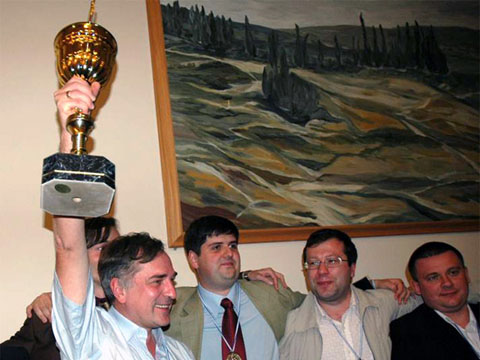

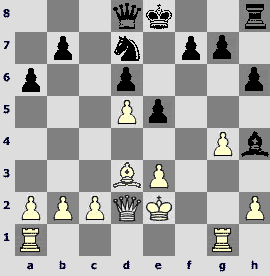

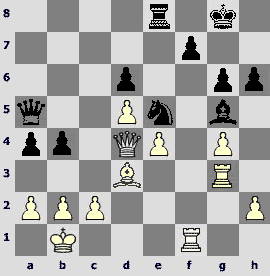
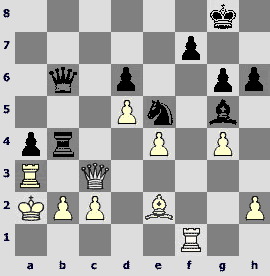

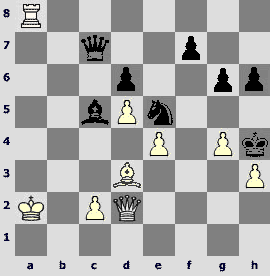
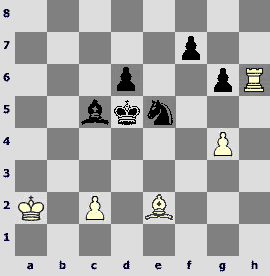
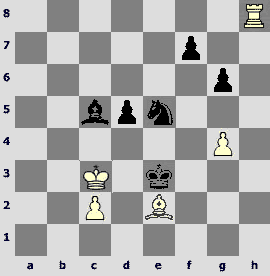
Moscow 1981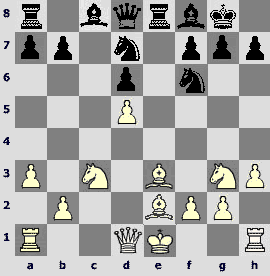
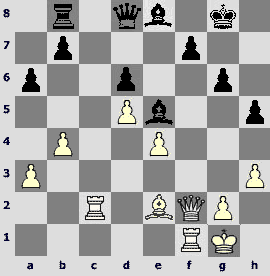
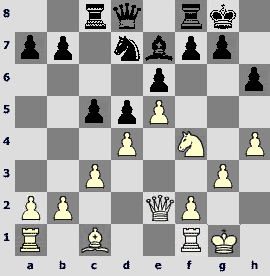

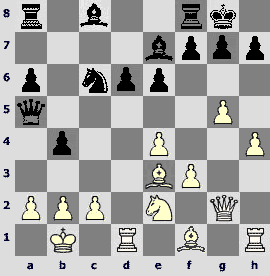
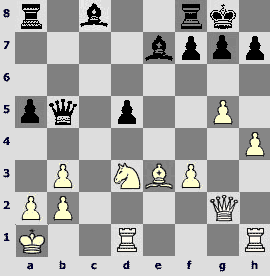
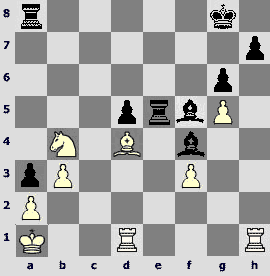
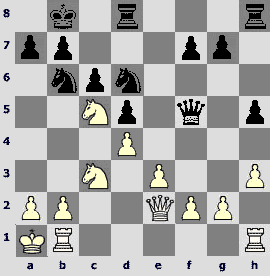
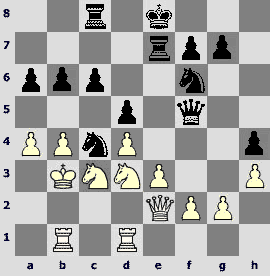
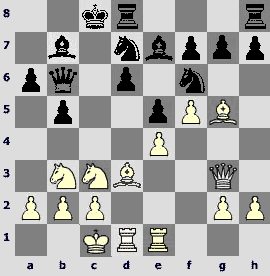
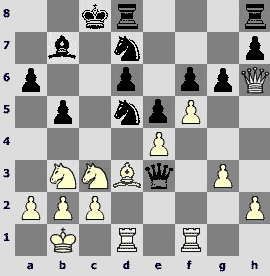
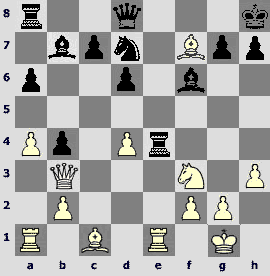
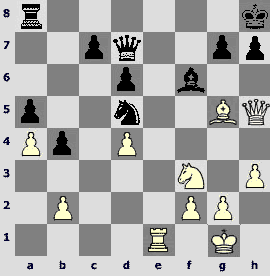
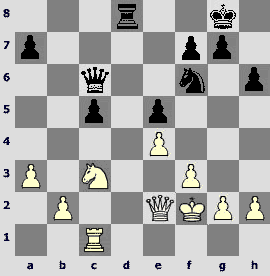
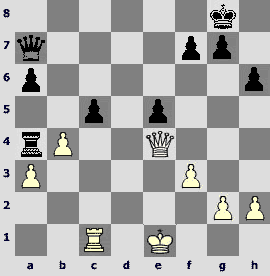
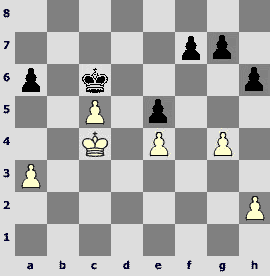



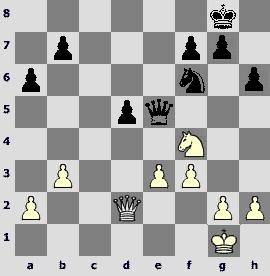
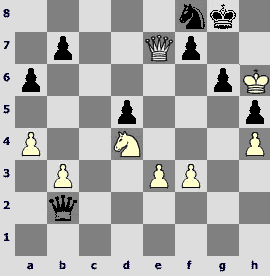


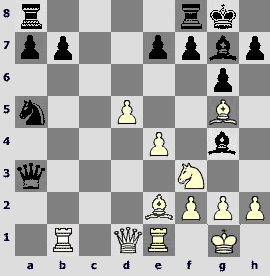
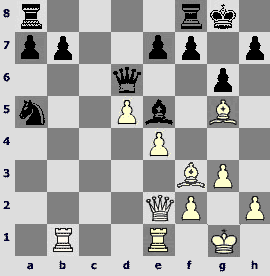


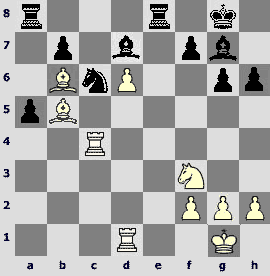
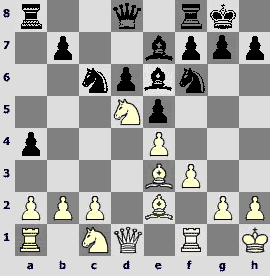
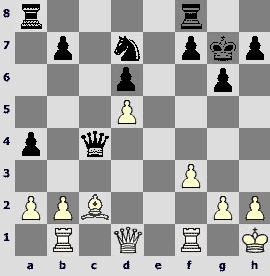
ALL ARTICLES BY AUTHOR
